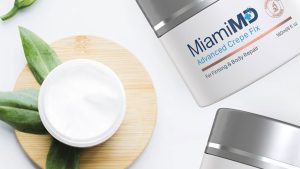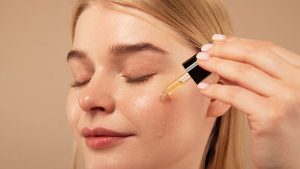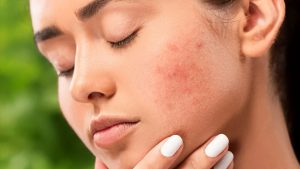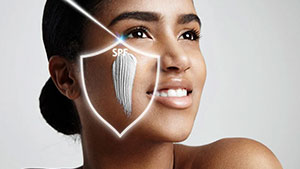What Is Glycolic Acid And Why Is It Beneficial In Skin Care?
If you’re new to skin care, the idea of putting acid on your face likely sounds like something you should avoid at all costs. But glycolic acid is one of the shining stars of any skin care routine, especially those looking to help with age related concerns.
MiamiMD stays on top of anything that has the potential to help you defy your age and reveal your best skin, which is why we’ve chosen to include glycolic acid in some of our functional beauty skin care products.
Let’s talk more about what it is and why it is a beneficial ingredient to include in your skin care routine.
What is Glycolic Acid, and How Does It Work?
To begin, glycolic acid is classified as an alpha hydroxy acid, or AHA. There are also beta hydroxy acids, which include chemicals like salicylic acid, but AHAs are unique in their chemical formulation. They are organic molecules and contain carbon. Other types of alpha hydroxy acids are lactic acid and citric acid.
Alpha hydroxy acids like glycolic acid are a class of chemicals that work to gently exfoliate the skin. Glycolic acid is actually derived from sugar cane and certain fruits, and is included in a variety of different topical skin care products like serums, toners, and creams. There are other stronger forumatulions of glycolic acid as well, which are used in at-home “peels.”
When it comes to size, glycolic acid is considered the smallest molecule of all available AHAs. That makes it especially attractive because it is able to be far more easily absorbed into the skin than some of the other AHAs on the market.
When it enters the skin, it goes to work on the bonds that are still in place between dead skin cells (known as keratinocytes). Once those bonds are loosened or removed, the dead skin cells can be much more easily swept away. Even though the skin cells are replaced roughly every 27 days, it doesn’t hurt to help your skin out once in a while!
Glycolic acid is also thought to help trigger the production of collagen when used over time. That means, in addition to being able to even the skin tone and reduce dark spots, glycolic acid can also help to lessen the appearance of fine lines and wrinkles and firm the skin. It may also be able to boost the body’s natural production of hyaluronic acid which, much like collagen, helps to keep the skin firm, plump, and hydrated.
Why Should I Use Glycolic Acid?
Because of how glycolic acid works, by sweeping away those dull, dead skin cells that sit on the surface of the skin and dull its radiance, your complexion will naturally look smoother and more evenly toned. That is also part of the reason that glycolic acid is known as a skin brightening agent. If used regularly, glycolic acid may also help to lighten dark spots (hyperpigmentation), although a side effect is that freckles may also be affected.
As that “sloughing” of the skin occurs over time, another benefit is that it helps to remove the gunk and buildup from the pores on the face. In addition, clearer, more open pores are much better at being able to absorb any products that you may be putting on it (we recommended focusing on using “functional beauty” products that can help you look great minutes after using them, while still providing long term benefits).
In addition, many people use physical exfoliants to try to get the same results. However, those physical exfoliants are also very rough on the skin, and can even cause permanent damage. Being rough to your skin, even just drying it too hard with a towel, can also speed up the symptoms of aging and worsen fine lines and wrinkles.
Physical exfoliation of any kind is generally not recommended by dermatologists, which is part of what makes chemical exfoliants like glycolic acid so popular.
To summarize, some of the key benefits that glycolic acid can provide for the skin include:
- Reducing the appearance of fine lines and wrinkles
- Minimizing the appearance of pores
- Removing dead skin cells to reveal brighter skin
- Evening out the skin tone
How Does MiamiMD Use Glycolic Acid?
We use glycolic acid in one of our products, our Dark Spot Corrector. Our Dark Spot Corrector was formulated to help to visibly reduce dark and aging spots. It also helps to transform patchy and stained skin into younger looking skin with a more even complexion with just a few weeks of use. It was designed so that it can be used on the face as well as the hands and the chest.
In our Dark Spot Corrector, glycolic acid helps remove that outer layer of dead skin cells, helping to quickly fade, diminish, and then virtually completely disappear the appearance of dark spots.
In addition to glycolic acid, we also use kojic acid in our formulation. However, unlike glycolic acid, kojic acid does not qualify as a hydroxy acid. Instead, kojic acid is produced by several different types of fungi. It does work in a similar way to glycolic acid, though, in that it is incredible at lightening dark spots and brightening the skin, helping to “supercharge” your results.
Our Dark Spot Corrector was specifically formulated with ingredients that can visibly correct the symptoms of “DNA Discoloration” — things like sun spots, dark spots, liver spots, freckles, and age spots.
If you’re one of the millions of women out there who are actively having their youth stolen by visible dark spots on your face, hands, and/or chest, our formula has the potential to take years off your appearance.
With ingredients like alpha-arbutin, resveratrol, and vitamin C, our corrector can inhibit the production of tyrosinase, rebuff negative environmental influences, and brighten tired-looking complexions quickly.
The luxurious cream formula is able to both safely and painlessly slough off that skin that has been subjected to DNA damage, the type of damage that can make the skin look older and unhealthy.
Once that old, unhealthy skin is removed, the glowing, bright, even skin you’re looking for will finally be able to shine through.
Are There Any Other Products That Work Like Glycolic Acid?
When it comes to brightening the skin and helping promote a more youthful appearance, glycolic acid really is top notch. However, that doesn’t mean that there aren’t other products out there that may be able to work just as well.
The closest ingredient that can get similar results to the results that can come from glycolic acid is vitamin C. With vitamin C, it helps to even out skin tone, smooth rough texture, and reduce the appearance of fine lines, wrinkles, and scars.
That’s why we included vitamin C alongside glycolic acid in our Dark Spot Corrector. When you use a formula that contains multiple different ingredients known for their anti-aging and skin brightening properties, you’ll see better results than if you were to use either of those ingredients on their own.
Ultimately, though, even if there are products that may provide similar benefits to glycolic acid, there really aren’t very many products out there that work quite as well. That’s why we included it in our skin care line in the first place, and why we believe it can be very beneficial for people of any age or any skin type.
What Should I Know About Glycolic Acid?
Because of glycolic acid’s exfoliation properties, and since it essentially gently removes out the top layer of the skin, skin that isn’t used to the ingredient may experience some initial dryness or irritation. It may help to layer products that contain glycolic acid with a heavy moisturizer.
The good news is that most of the irritation that comes with new glycolic acid use is mostly for people who use higher percentages or glycolic acid as a single active ingredient.
If you ease into its use or use it in a formula like ours that includes it in a blend of other ingredients, you’re far less likely to experience any of those side effects.
In Conclusion…
Glycolic acid is one of the best skin care ingredients out there, helping to both brighten the overall appearance of the skin and improve its tone and natural radiance.
Over time, a skin care regimen that includes products with glycolic acid, like MiamiMD’s Dark Spot Corrector, can help diminish the appearance of dark spots and be your fountain of youth in a bottle.
Sources:
https://www.sciencedirect.com/topics/medicine-and-dentistry/tyrosinase





